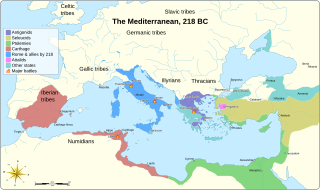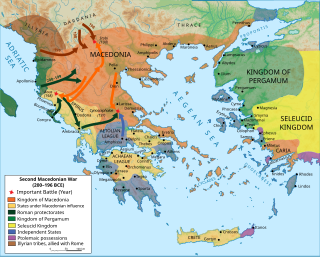Related Research Articles

Galatia was an ancient area in the highlands of central Anatolia, roughly corresponding to the provinces of Ankara and Eskişehir, in modern Turkey. Galatia was named after the Gauls from Thrace, who settled here and became a small transient foreign tribe in the 3rd century BC, following the Gallic invasion of the Balkans in 279 BC. It has been called the "Gallia" of the East.

Seleucus II Callinicus Pogon, was a ruler of the Hellenistic Seleucid Empire, who reigned from 246 BC to 225 BC. Faced with multiple enemies on various fronts, and not always successful militarily, his reign was a time of great turmoil and fragmentation for the Seleucid Empire, before its eventual restoration under his second son and eventual successor, Antiochus III.

Antiochus III the Great was a Greek Hellenistic king and the 6th ruler of the Seleucid Empire, reigning from 223 to 187 BC. He ruled over the region of Syria and large parts of the rest of western Asia towards the end of the 3rd century BC. Rising to the throne at the age of eighteen in April/June 223 BC, his early campaigns against the Ptolemaic Kingdom were unsuccessful, but in the following years Antiochus gained several military victories and substantially expanded the empire's territory. His traditional designation, the Great, reflects an epithet he assumed. He also assumed the title Basileus Megas, the traditional title of the Persian kings. A militarily active ruler, Antiochus restored much of the territory of the Seleucid Empire, before suffering a serious setback, towards the end of his reign, in his war against Rome.

Philip V was king of the ancient Greek kingdom of Macedon from 221 to 179 BC. Philip's reign was principally marked by the Social War in Greece and a struggle with the emerging power of the Roman Republic. He would lead Macedon against Rome in the First and Second Macedonian Wars. While he lost the latter, Philip later allied with Rome against Antiochus III in the Roman-Seleucid War. He died in 179 BC from illness after efforts to recover the military and economic condition of Macedonia and passed the throne onto his elder son, Perseus of Macedon.

The First Macedonian War was fought by Rome, allied with the Aetolian League and Attalus I of Pergamon, against Philip V of Macedon, contemporaneously with the Second Punic War against Carthage. There were no decisive engagements, and the war ended in a stalemate.

The Second Macedonian War was fought between Macedon, led by Philip V of Macedon, and Rome, allied with Pergamon and Rhodes. Philip was defeated and was forced to abandon all possessions in southern Greece, Thrace and Asia Minor. During their intervention, although the Romans declared the "freedom of the Greeks" against the rule from the Macedonian kingdom, the war marked a significant stage in increasing Roman intervention in the affairs of the eastern Mediterranean, which would eventually lead to Rome's conquest of the entire region.

Lysimachus was a Thessalian officer and successor of Alexander the Great, who in 306 BC, became king of Thrace, Asia Minor and Macedon.

Sestos was an ancient city in Thrace. It was located at the Thracian Chersonese peninsula on the European coast of the Hellespont, opposite the ancient city of Abydos, and near the town of Eceabat in Turkey.

The Kingdom of Pergamon, Pergamene Kingdom, or Attalid kingdom was a Greek state during the Hellenistic period that ruled much of the Western part of Asia Minor from its capital city of Pergamon. It was ruled by the Attalid dynasty.

The Wars of the Diadochi or Wars of Alexander's Successors were a series of conflicts fought between the generals of Alexander the Great, known as the Diadochi, over who would rule his empire following his death. The fighting occurred between 322 and 281 BC.

Eumenes II Soter was a ruler of Pergamon, and a son of Attalus I Soter and queen Apollonis and a member of the Attalid dynasty of Pergamon.

The Dying Gaul, also called The Dying Galatian or The Dying Gladiator, is an ancient Roman marble semi-recumbent statue now in the Capitoline Museums in Rome. It is a copy of a now lost Greek sculpture from the Hellenistic period thought to have been made in bronze. The original may have been commissioned at some time between 230 and 220 BC by Attalus I of Pergamon to celebrate his victory over the Galatians, the Celtic or Gaulish people of parts of Anatolia. The original sculptor is believed to have been Epigonus, a court sculptor of the Attalid dynasty of Pergamon.

Achaeus was a general and later a separatist ruler of part of the Greek Seleucid kingdom. He was the son of Andromachus, whose sister Laodice II married Seleucus II Callinicus, the father of Antiochus III the Great. He accompanied Seleucus III Ceraunus, the son of Callinicus, in his expedition across mount Taurus against Attalus I, and after the assassination of Seleucus III Ceraunus revenged his death; and though he might easily have assumed the royal power right then, he remained faithful to Antiochus III, brother of Seleucus III, for the time being, that is until he proclaimed himself king in 220 BC.
Mithridates IV of Pontus, sometimes known by his full name Mithridates Philopator Philadelphus, was a prince and sixth ruler of the Kingdom of Pontus.

The Battle of the Eurymedon, also known as the Battle of Side took place in August 190 BC. It was fought as part of the Roman–Seleucid War, pitting the fleets of Rhodes under admiral Eudamus against a Seleucid fleet of Hannibal.

Attalus I, surnamed Soter, was the ruler of the Greek polis of Pergamon and the larger Pergamene Kingdom from 241 BC to 197 BC. He was the adopted son of King Eumenes I, whom he succeeded, and was the first of the Attalid dynasty to assume the title of king, sometime around 240 to 235 BC. He was the son of Attalus and his wife Antiochis.

The Cretan War was fought by King Philip V of Macedon, the Aetolian League, many Cretan cities and Spartan pirates against the forces of Rhodes and later Attalus I of Pergamum, Byzantium, Cyzicus, Athens, and Knossos.

The Roman–Seleucid war (192–188 BC), also called the Aetolian war, Antiochene war, Syrian war, and Syrian-Aetolian war was a military conflict between two coalitions, one led by the Roman Republic and the other led by the Seleucid king Antiochus III. The fighting took place in modern-day southern Greece, the Aegean Sea, and Asia Minor.

The Battle of the Caecus River or Battle of the Kaikos was a battle between an army of the Kingdom of Pergamon commanded by Attalus I, and the Galatian tribes who resided in Anatolia. The battle took place near the source of the Caecus River and resulted in a victory for the Kingdom of Pergamon.

The Galatians were a Celtic people dwelling in Galatia, a region of central Anatolia in modern-day Turkey surrounding Ankara during the Hellenistic period. They spoke the Galatian language, which was closely related to Gaulish, a contemporary Celtic language spoken in Gaul.
References
- ↑ Strobel, Karl (Klagenfurt) (October 2006). "Aegosages". brillonline. Brill’s New Pauly. Retrieved 28 February 2022.
- ↑ Cohen, Getzel M. (1995). The Hellenistic Settlements in Europe, the Islands, and Asia Minor. University of California Press. p. 145. ISBN 9780520914087.
- ↑ Polybius, V 77,2-78,6.
- ↑ Polybius, V 111.